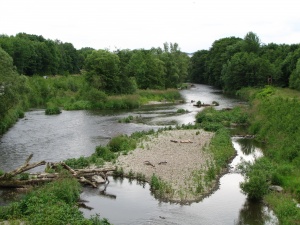Difference between revisions of "Ruhr Binnerfeld"
(→Measures selection) |
(→Contact person within the organization) |
||
| (4 intermediate revisions by the same user not shown) | |||
| Line 14: | Line 14: | ||
[[File:Ruhr_1.JPG|300px|thumb|left|Restored site of Ruhr Binnerfeld]] | [[File:Ruhr_1.JPG|300px|thumb|left|Restored site of Ruhr Binnerfeld]] | ||
| − | |||
| − | |||
| − | |||
| − | |||
| − | |||
| − | |||
| − | |||
| Line 68: | Line 61: | ||
==Contact person within the organization== | ==Contact person within the organization== | ||
| + | |||
| + | Dr. Armin Lorenz | ||
| + | |||
| + | University of Duisburg-Essen, Aquatic Ecology | ||
| + | |||
| + | armin.lorenz@uni-due.de | ||
==Extra background information== | ==Extra background information== | ||
| Line 74: | Line 73: | ||
http://www.arnsberg.de/umwelt/wasser/renaturierung_binnerfeld.php | http://www.arnsberg.de/umwelt/wasser/renaturierung_binnerfeld.php | ||
| − | + | ||
Latest revision as of 15:25, 28 May 2014
Ruhr Binnerfeld
Key features of the case study
Site description
The restored site Binnerfeld in the river Ruhr is located in the Federal State of Northrhine-Westfalia in the urban area of the city Arnsberg. The Ruhr in Arnsberg belongs to the NATURA 2000 area, serves as an important place for local recreation and is highly frequented by cyclists, walkers and canoeists. Prior to restoration the river was flowing monotonously in a constrained and narrow planform fixed at the banks by riprap. The main aims of the restoration measures were to restore more natural hydromorphological conditions and to re-establish longitudinal connectivity resulting in a higher morphological and biologcial diversity. Moreover, it aimed to increase the aesthetic value of the river section and to raise people’s awareness of the importance of biodiversity by making nature tangible. Restoration measures were implemented step-by-step from 2007 to 2012 on a total river length of 3.5 km.
Measures selection
Restoration measures conducted:
- removal of bank fixation to initiate bankside erosion
- creation of flood-prone areas
- widening of river bed
- creation of side arms
- restructuring of river bed and banks by sediment addition
- placement of large wood
Success criteria
Ecological response
Hydromorphological response
Monitoring before and after implementation of the project
Socio-economic aspects
The area along the Ruhr serves as an important place for local recreation and is highly frequented by cyclists, walkers and canoeists. Furhtermore cafes and restaurant close to the restored site were built.
Contact person within the organization
Dr. Armin Lorenz
University of Duisburg-Essen, Aquatic Ecology
armin.lorenz@uni-due.de
Extra background information
References
http://www.arnsberg.de/umwelt/wasser/renaturierung_binnerfeld.php
Related Measures
- Add/feed sediment
- Widen water courses
- Allow/increase lateral channel migration or river mobility
- Shallow water courses
- Add sediments
- Initiate natural channel dynamics to promote natural regeneration
- Introduce large wood
- Remove bank fixation
- Recreate gravel bar and riffles
- Adjust land use to develop riparian vegetation
- Remove bank fixation
- Improve backwaters
- Lower river banks or floodplains to enlarge inundation and flooding
- Remove hard engineering structures that impede lateral connectivity
- Set back embankments, levees or dikes
- Retain floodwater
